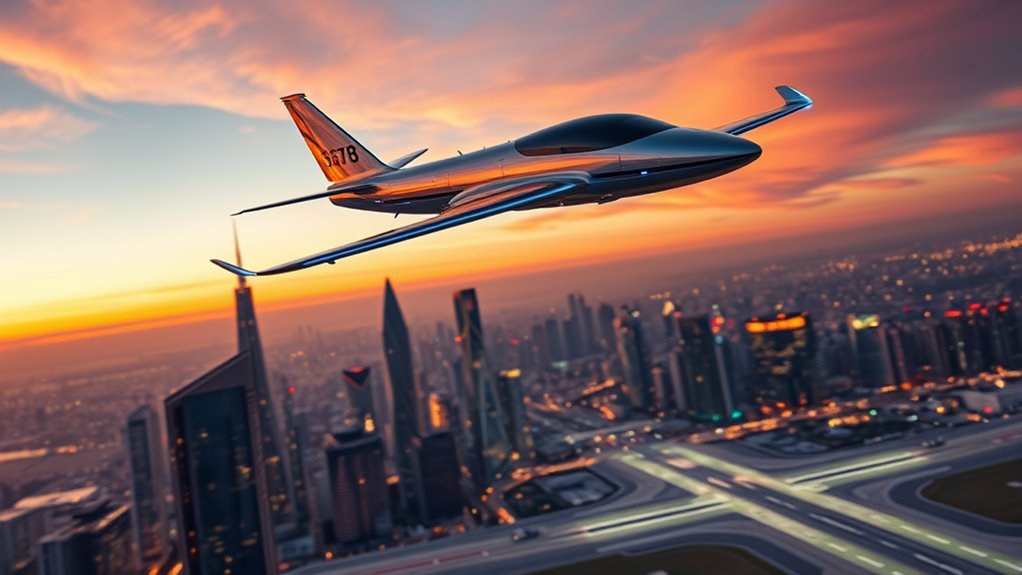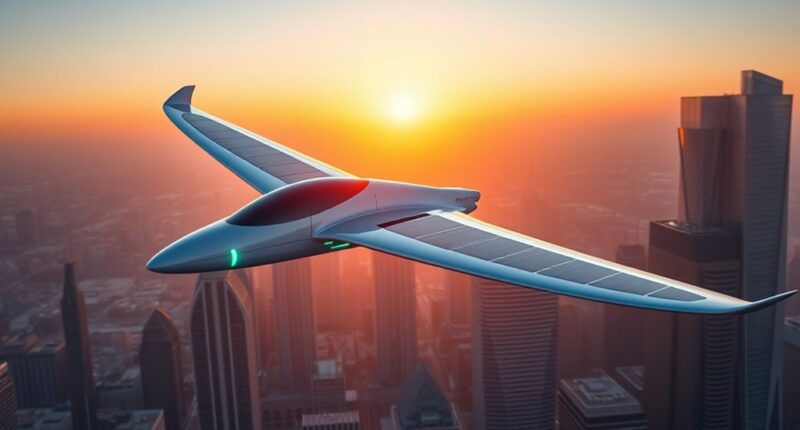Zero-emission flights are closer than you might think, but widespread adoption depends on advances in battery tech and supportive regulations. Currently, batteries are too heavy and lack the energy density needed for long flights, limiting electric aviation mostly to short routes. As researchers develop better energy storage and governments establish clearer safety standards, electric flights will become more practical. Stay with us to uncover how these innovations could transform your travel experience in the future.
Key Takeaways
- Electric aircraft currently mainly serve short-haul routes due to battery weight and energy density limits.
- Advancements in battery technology are essential for enabling longer, zero-emission commercial flights.
- Regulatory frameworks and safety standards are still being developed, delaying widespread adoption.
- Infrastructure upgrades like airport charging stations are necessary but require regulatory approval and investment.
- Full-scale zero-emission flights are anticipated within the next decade as technology and regulations progress.

Have you ever wondered how electric aviation could transform the future of travel? As technology advances, the idea of zero-emission flights becomes more realistic, but there are still significant hurdles to overcome. One of the most critical factors is battery technology. Unlike traditional fuel-powered engines, electric planes rely on batteries to store and deliver energy. Currently, batteries are heavy and have limited energy density, which restricts the size and range of electric aircraft. Researchers are making strides in developing better energy storage solutions, but it’s a slow process. To make electric flights practical for commercial use, batteries need to become lighter, more efficient, and faster to recharge. Until then, electric aviation remains a promising but limited option for short-haul flights or niche markets.
Alongside technological issues, regulatory challenges also play a substantial role in delaying the widespread adoption of electric aircraft. Aviation authorities, such as the FAA and EASA, are still in the process of establishing comprehensive standards for electric planes. These regulations are vital to ensure safety, reliability, and environmental benefits, but they tend to lag behind technological innovations. Developing new rules takes time and extensive testing, which can slow down the deployment of electric aircraft. Airlines and manufacturers need clarity on certification processes, safety protocols, and operational limitations before they can confidently invest in electric fleets. Furthermore, infrastructure upgrades, like charging stations at airports, require regulatory approval and significant investment, adding another layer of complexity.
You might think that technological innovation alone could accelerate the shift to electric aviation, but regulatory frameworks are equally crucial. Without clear guidelines and supportive policies, manufacturers hesitate to bring new aircraft to market, fearing delays or rejection. Governments and industry stakeholders must work together to streamline certification processes and foster a regulatory environment that encourages innovation while maintaining safety standards. This coordination is essential for scaling up electric aviation from experimental prototypes to mainstream commercial aircraft.
In essence, the future of zero-emission flights depends on solving these twin challenges: advancing battery technology and charting regulatory landscapes. Progress is happening, but it’s a gradual process. As batteries improve and regulations evolve, electric aviation will become more viable, making shorter flights cleaner and more sustainable. Additionally, ongoing research in Kia Tuning demonstrates how technological advancements in automotive fields can inform broader transportation innovations. While the timeline remains uncertain, it’s clear that overcoming these barriers is key to unlocking the full potential of electric flight and transforming how we travel.
Frequently Asked Questions
What Are the Main Barriers to Widespread Electric Aviation Adoption?
The main barriers to widespread electric aviation adoption include limited battery recycling infrastructure and insufficient government incentives. You might find that battery recycling is essential to address environmental concerns and resource sustainability. Without strong government incentives, airlines lack motivation to invest in electric planes, which hampers progress. Overcoming these challenges requires coordinated efforts to develop recycling systems and implement policies that support electric aviation’s growth.
How Do Electric Planes Compare in Safety to Traditional Aircraft?
You might wonder how electric planes compare in safety to traditional aircraft. Electric planes generally have safer battery systems due to advanced battery safety features, reducing fire risks. Pilot training is vital, as pilots need to learn new procedures for electric systems. While electric aircraft are still emerging, ongoing innovations aim to match or surpass traditional safety standards, making them a promising and safe alternative for future flights.
What Is the Expected Lifespan of Electric Aircraft Batteries?
Think of your electric aircraft battery as a marathon runner—it’ll perform well for years but gradually slow down. Typically, it’s designed for about 8-10 years, but battery degradation can shorten this lifespan. Recycling challenges also loom, as old batteries need careful handling to prevent environmental harm. With ongoing advances, expect batteries to improve, lasting longer and becoming easier to recycle, making electric flights more sustainable over time.
Are There Specific Airports Equipped for Electric Aircraft Charging?
You’ll find that many airports are upgrading their infrastructure to support electric aircraft charging, but not all are fully equipped yet. Airport readiness varies, with some installing specialized charging stations and others still planning upgrades. As electric aviation grows, expect more airports to develop dedicated charging infrastructure, making it easier for you to charge your aircraft conveniently. Staying informed about these developments will help you take advantage of zero-emission flights more readily.
How Will Electric Aviation Impact Airline Ticket Prices?
You’ll likely see lower airline ticket prices as electric aviation advances, thanks to cost reduction in aircraft maintenance and fuel. Electric planes are cheaper to operate, which can boost passenger affordability. In the long run, this could make flying more accessible for everyone. As technology improves and infrastructure expands, expect more competitive prices, making air travel more budget-friendly and sustainable, benefiting both travelers and the environment.
Conclusion
So, while the future of zero-emission flights is on the horizon, it might still be a few years before you’re jetting around in silent, eco-friendly planes—think of it as the dawn of a new age, not unlike the invention of the wheel. Keep your eyes on the skies; electric aviation is gaining momentum faster than you can say “hovercraft.” One thing’s certain: the era of emissions-free flying is just around the corner, and it’s worth the wait.










